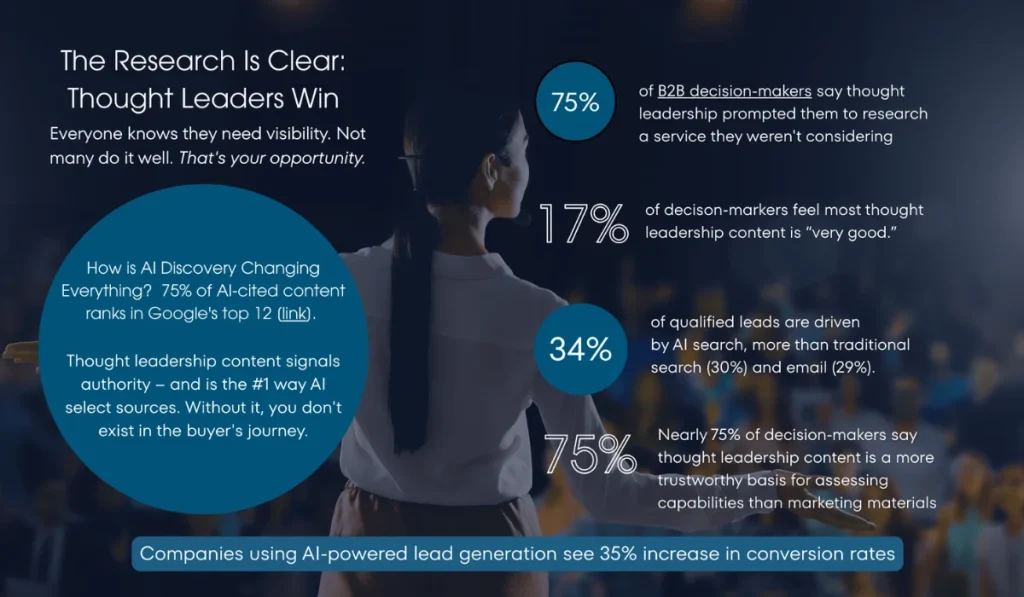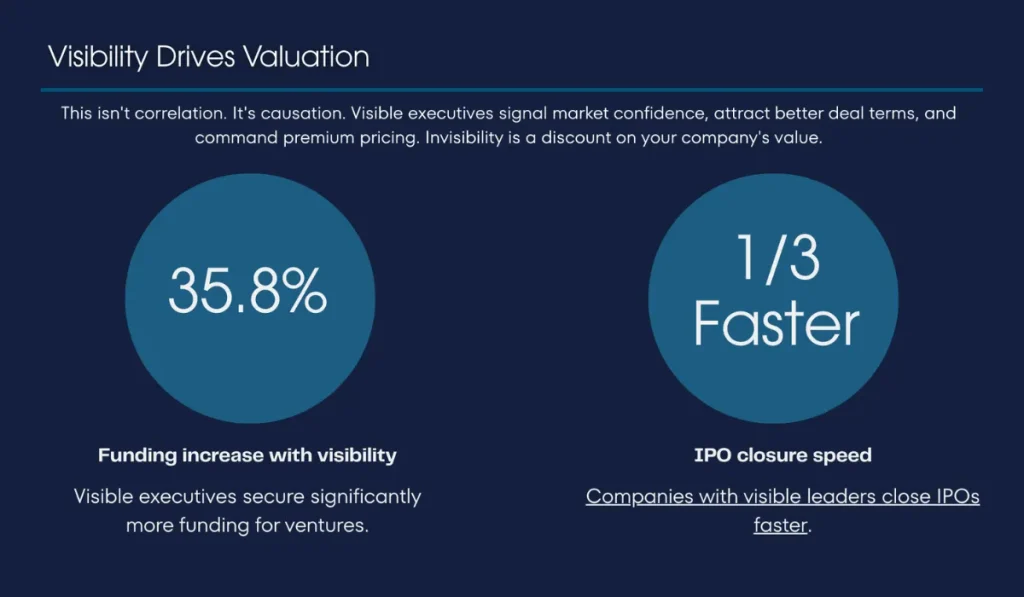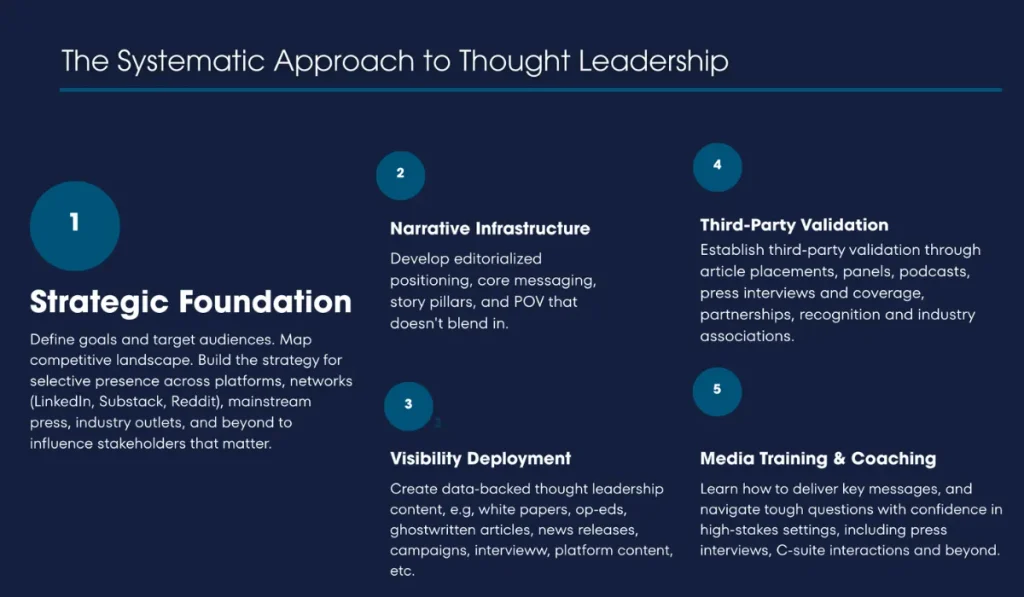After nearly 20 years positioning leaders from Gap Inc. and Amazon to fundraising founders, I’m seeing a fundamental shift in how executive visibility translates into revenue.
Today, leaders need to be more than visible. They need to be the kind of thought leaders that signal authority.
7 Executive Communication Trends for Leaders in 2026
1. AI Search Dominance: Your Authority Must Be Machine-Readable
The buyer’s journey has fundamentally shifted from Google to AI. 34% of qualified leads now come from AI search, surpassing traditional search at 30% and email at 29%.

When prospects ask ChatGPT, Perplexity, or Claude “Who are the leading experts in [your space]?”, AI doesn’t run a Google search, it looks for authority signals. 75% of AI-cited content ranks in Google’s top 12, with authority being the #1 factor.
If you’re not positioned as an authority, you literally don’t exist in the buyer’s journey. Build thought leadership content optimized for AI discovery, not just Google SEO.
2. The “Hidden Buyer” Economy: 55% of Decision-Makers You Never Meet
The buying committee has expanded beyond the people your sales team talks to. 55% of hidden decision-makers evaluate thought leadership just like primary buyers – those who are influencers you never meet in a sales call.
More than 40% of B2B deals stall due to internal misalignment within buying groups. Your visibility program must reach people who will never attend a sales call or demo. Instead, they’re researching independently and influencing decisions behind the scenes.
3. Premium Pricing Through Thought Leadership
Visibility isn’t just about awareness, it’s about pricing power. 60% of B2B decision-makers will pay a premium for organizations that provide valuable thought leadership.
73% of buyers consider thought leadership a more trustworthy basis for judging competencies than traditional marketing materials, and 86% would be moderately or very likely to invite organizations with strong thought leadership to participate in an RFP process.
When you’re recognized as an authority, you’re not competing on price, you’re commanding premium positioning.
4. Quality Over Noise: The 17% Gap
There’s a massive quality gap in thought leadership. Only 17% of decision-makers think that thought leadership is very good, yet 75% say it prompted them to research services they weren’t originally considering.
Everyone knows they need thought leadership. Almost no one does it well. The bar is surprisingly low—which means quality wins disproportionately. Invest in fewer, better pieces vs. high-volume mediocre content.

5. Messaging Foundation Before Amplification
Executives and leaders, alike, are realizing they can’t post their way to authority. Without clear positioning and differentiated messaging, visibility just amplifies confusion. As AI-driven research accelerates buyer journeys, unclear messaging costs you opportunities at scale.
Build your messaging architecture before launching content campaigns: define your positioning, clarify your differentiation, develop your narrative, and create message frameworks your communications team can execute consistently. Strategy before tactics. Foundation before deployment.
6. Video + Voice: Multi-Modal Authority Building
Text-only thought leadership is no longer enough. Podcasts, video interviews, webinars, and speaking engagements are becoming table stakes. In fact, LinkedIn video content generates 5× more engagement than text posts.
Executives comfortable on camera, mic and stage, will have a significant competitive advantage. Those who refuse to appear in these formats will lose ground to competitors. Investing in media training and video presence development will help you overcome apprehension.
7. Defense Matters As Much As Offense
Most executives think about thought leadership as an acquisition strategy. They’re missing the retention play. Consider: 70% of C-suite leaders have questioned their current supplier after reading a competitor’s thought leadership, and 25% ended or significantly reduced their relationship as a result.
While you’re focused on new business, your competitors’ thought leadership is actively undermining your existing client relationships. Protect existing revenue by staying visible to current clients. Don’t assume your work speaks for itself.
Takeaway
Every one of these shifts points to the same reality: executive visibility is no longer optional.
The executives who win in 2026 will appear in AI-generated results, reach hidden buyers who never attend sales calls, command premium pricing, produce quality thought leadership, build messaging foundations before amplifying tactics, show up in video and audio, and defend existing revenue while pursuing new business.

Ready to Position Yourself for 2026?
The Executive Visibility & Authority Program provides strategic infrastructure across three pillars: messaging foundation & strategic positioning, authority-building content for AI discovery, and multi-channel visibility execution.
Let’s talk if you’re ready to close the authority gap in 2026.
About Verified Communications: Toronto-based strategic communications firm trusted since 2016. We have experience working with Gap Inc., Amazon, Walmart, and ambitious companies that demand big-brand thinking without the big agency bloat.
Connect with us today.




